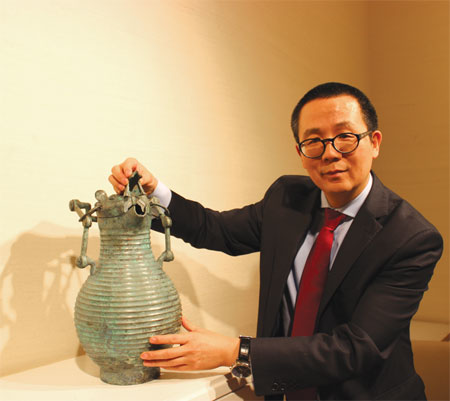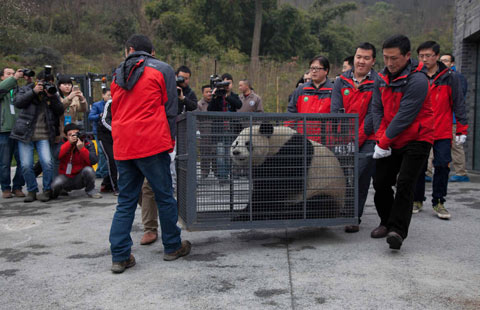Rare Zhou bronze wine vessel goes on the block
Updated: 2014-02-21 13:16
By Liu Lian in New York (China Daily USA)
|
||||||||
|
Wang Tao, head of Chinese Works of Art at Sotheby's, showcases a rare Chinese bronze owl-headed ritual wine vessel (hu), which is to be auctioned on March 18 and one of the highlights of the auction house's Asian art sales in March. The vessel dated back to eastern Zhou Dynasty. Liu Lian / China Daily |
A very rare Chinese archaic bronze owl-headed ritual wine vessel dating to the eastern Zhou Dynasty (771-221 BC), will be auctioned at Sotheby's on March 18.
The New York auction house acquired the bronze one week ago from Sakamoto Goro, a well-known Japanese antiques dealer.
The 18.25 inch-tall bronze vessel is pear-shaped and encircled by 30 horizontal grooves. Though patinated by time, the design is clear and intact. The cover of the vessel was carved in the form of an owl's head with a beak as the spout. Inside the cover there are inscriptions of nine characters. The piece is believed to have been produced and excavated in north China's Shandong province.
Animal motifs were widely used in early Chinese art, showing significant cultural influence of the Northern Steppes, said Jason Sun, curator of the Asian Art department at the Metropolitan Museum of Art.
"The symbol of the owl has its roots in ancient mysteries, but it also a symbol in reverence to ancestors," said Wang Tao, head of Chinese Works of Art at Sotheby's, "a hu is a vertical container for liquid. The wine vessel is, therefore, not only an achievement in the decorative details, but also functional and practical."
The provenance of the bronze vessel was traced back to late 19th century, and had been well documented and studied since by Chinese and Western scholars. The first recorded collector was a Chinese scholar named Wu Yun (1811-1883). In a letter, Wu said the vessel was first found in a metal recycling store in Shanghai in 1861 and sold to a friend of his from whom he acquired the piece in an exchange.
It was taken to Europe in the 1930s and its first recorded sale in the West took place in 1945 for 1,134 pounds, a formidable amount at the time. Guiseppe Eskenazi, a distinguished London-based dealer, sold it to the British Rail Pension Fund in 1978 for 120,000 pounds. Sotheby's London held the last auction of the bronze piece in 1989 where the current owner Sakamoto Goro bid more than 480,000 pounds, four times its sale estimate.
Chinese bronze pieces have been a subject of interest to Chinese over millenniums because they are regarded as one of the most ancient arts, if not the only art that was created at the time, said Henry Howard-Sneyd, Sotheby's vice-chairman of Asian art.
"Created in a very durable material, they were able to survive to the present day and in many cases in remarkable conditions," he said..
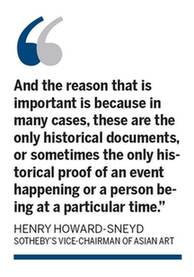
Chinese bronzes of the archaic period (1900 BC-221BC) were often one of a kind, said Wang, until the Han dynasty (206 BC-220 AD), they were cast in ceramic piece-molds, rather than wax casting. Despite the complexity of the designs, the casting was done in a single cast, one of the highest craft achievements in Chinese art history.
The bronzes from western Zhou Dynasty onward are worth noting because they have lengthy descriptions applied to the pieces, said Howard-Sneyd.
"And the reason that is important is because in many cases, these are the only historical documents, or sometimes the only historical proof of an event happening or a person being at a particular time," he said.
In 2011, China overtook the US as the world's largest art market. Annual sales of auction houses in mainland China reported about $4.4 billion in 2012, led by Chinese calligraphy and paintings, porcelain and contemporary Chinese art, according to a report released by the China Association of Auctioneers and Artne.
Until recent years, collectors shied away from archaic Chinese bronzes due to their limited knowledge and the limited market supplies. China's laws and regulations on protection of cultural relics prohibit transactions of Chinese archaic bronze excavated after 1949 and ones without provenance, which explains the bronze's lukewarm market status in China and why most high-ranking sales happened overseas, said Wang.
But the surging prices in the main categories of Chinese art prodded collectors for new options such as water ink paintings and the bronzes.
"This (Chinese bronze) is perhaps a field that has eclipsed in terms of the strength of Sotheby's other collection fields. Period Chinese porcelain for instance, the price began to move very fast in 2007 onwards. The bronze didn't really move at that time," said Howard-Sneyd, "It feels it (Chinese bronzes) is a field that has not had its day in the recent surge of prices in the Chinese art."
The highest amount paid for an ancient Chinese bronze was $12 million for a 2,500 year-old bronze figure of a tapir in March 2007 at the European Fine Art Fair (TEFAF) in the Dutch city of Maastricht on behalf of Littleton & Hennessy, the London and New York based specialist dealers in Asian art.
The highest record for a Chinese bronze in the US was set in 2001 by Christie's in New York; $9.24 million for a "Vincent dish" party jar from the Shang Dynasty.
Sotheby's New York held a single-owner sale of ritual bronzes from the collection of Julius Eberhardt last September. Originally valued at between $3.5 and $5.3 million, the 10-piece collection brought in a total of $16.78 million. "The buyers of the collection were all international collectors and none of them was from mainland China," said Wang.
That month, Christie's New York also held a sale of Chinese archaic bronzes from a private collection dating from the Shang to Han dynasties. They sold for a total of $6.26 million.
"Chinese bronze has a huge international appeal of great Western collections, great Japanese collections, great collections in other parts of the world, not just China," said Howard-Sneyd.
Increasing interests in Chinese bronze has meant that potential buyers ended up pushing up the price based on supply and demand economic rules, said Sun.
"Bronze is always historically considered being expensive in terms of the market. It's being a market of significant interests and importance, one that was not probably valued for maybe 15, 20 years," said Howard-Sneyd. "I would expect that to continue for another couple of years."
lianliu@chinadailyusa.com
(China Daily USA 02/21/2014 page2)

 Pentagon chief plans to reduce US army size
Pentagon chief plans to reduce US army size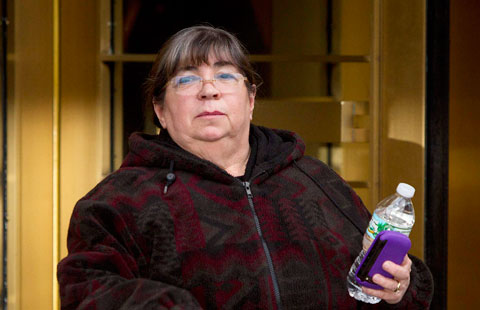
 2nd Madoff aide testifies, denies knowledge of fraud
2nd Madoff aide testifies, denies knowledge of fraud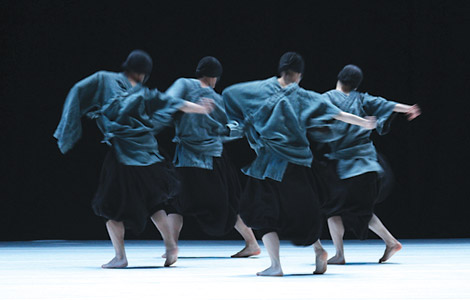
 TAO Dance troupe premieres '5' at NYU
TAO Dance troupe premieres '5' at NYU
 Top 10 cities with worst smog in China
Top 10 cities with worst smog in China
 Playing with pandas
Playing with pandas
 Explosion, gunfire ring out near Bangkok protest site
Explosion, gunfire ring out near Bangkok protest site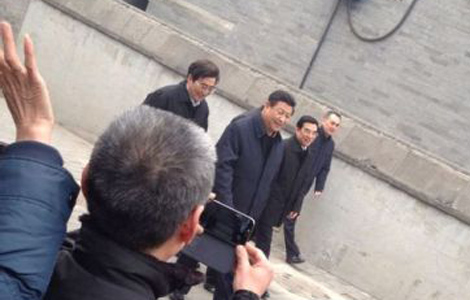
 President Xi spotted at popular hutong in Beijing
President Xi spotted at popular hutong in Beijing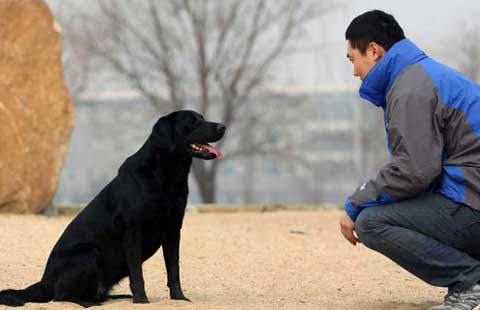
 Guide dogs trained in NE China
Guide dogs trained in NE China
Most Viewed
Editor's Picks
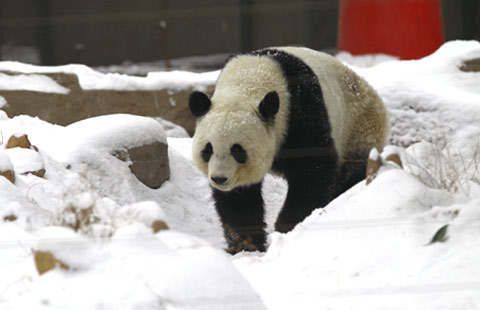
|
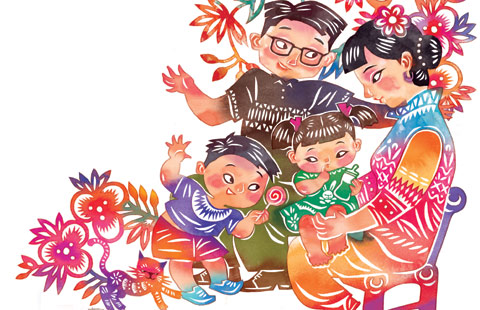
|

|

|

|

|
Today's Top News
US firms in China look to services, survey shows
Nanjing plans to preserve WWII 'comfort station'
Shanghai looks set for mini baby boom
Six officials caught in sex scandal sacked
China petition reform vows rule of law
Xi stresses core socialist values
Beijing protests US post on Tibet
President Xi pops in to Beijing's hutong
US Weekly

|

|
